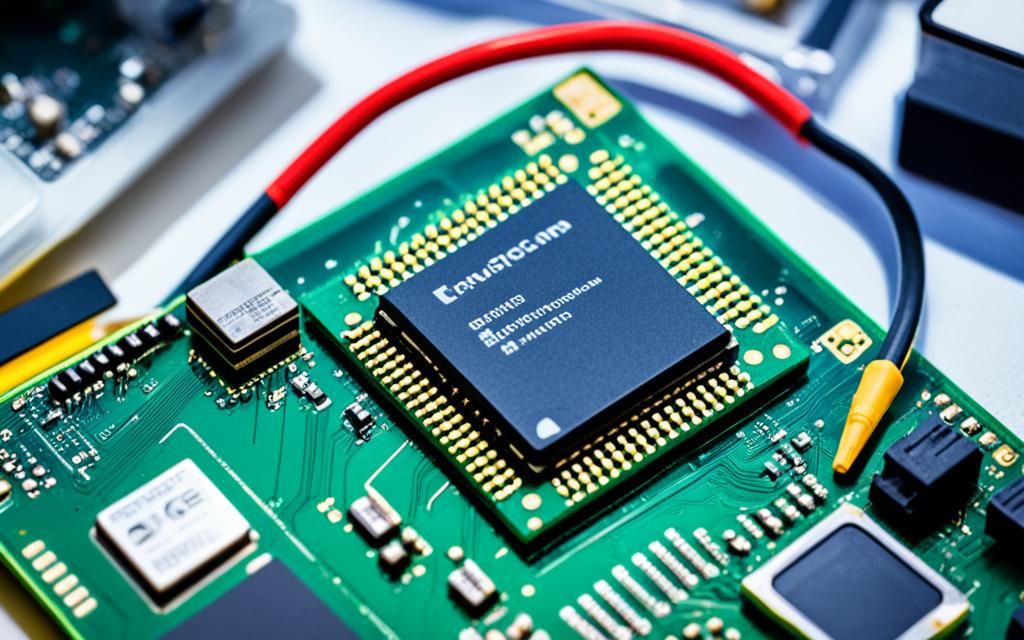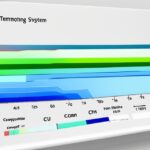Table of Contents
In the computing world, knowing how to deal with a dead CPU is crucial. The CPU acts as your computer’s brain. If it breaks down, everything stops. Spotting CPU symptoms early on can save you both time and money. Checking for issues like overheating, lack of power, and failure to boot is vital1. Learning to pinpoint CPU problems not only ups your tech skills. It also keeps your system running smoothly.
Key Takeaways
- Recognise signs of a failing CPU, including random shutdowns and screen freezes.
- Understanding the importance of proper hardware setup to diagnose CPU issues.
- Utilise visual inspections and listen for beep codes as part of the troubleshooting process.
- Seek professional assistance when DIY methods fail to resolve CPU problems.
- Implement preventative measures to prolong the lifespan of your CPU.
- Monitor for overheating issues as they can indicate a potential CPU failure.
- Regularly perform hardware checks to ensure all components are functioning correctly.
Understanding the Role of a CPU
The role of a CPU in a computer is crucial. It handles calculations and instructions, key for good performance. This central unit is vital as it controls nearly every task, from simple to complex. Issues with the CPU can lead to big problems, harming the system’s reliability and speed.
The Importance of the Central Processing Unit
The central processing unit acts as the computer’s brain. It carries out commands and keeps everything running smoothly. Its speed and efficiency are important for satisfying users. A CPU in good condition allows for smooth multitasking, improving how apps and activities work.
Common CPU Failures and Their Causes
CPUs can fail due to overheating, damage, or electrical issues. Signs of trouble include automatic shutdowns, freezing, or error messages2. Overheating is a common cause of CPU damage, often leaving burn marks near the socket3. Also, as CPUs age, they may become less stable, leading to problems4.
Signs of a Failing CPU
Spotting the early warning signs can prevent big problems and expensive fixes. Many devices show failing CPU symptoms that need quick attention. This knowledge allows users to act fast to avoid worse issues.
Recognising Symptoms: What to Look For
Several signs point to CPU trouble. It’s important for users to watch out for these indicators:
- Sudden shutdowns might mean the processor is not working right5.
- If your screen keeps freezing, it could be a CPU issue, happening after the system warms up5.
- Seeing the blue screen of death is a sure-fire sign of CPU problems5.
- If you hear beeping sounds when starting up, it could indicate a CPU issue, with patterns like five or seven beeps pointing to bigger concerns5.
- A fast-running fan at startup, without the OS loading, could mean the CPU is failing5.
Understanding No Functionality and Overheating
A non-responsive computer often means serious CPU troubles, even if the power seems fine6. Overheating is another serious issue. CPUs should stay between 86 and 122 °F. Above 158 °F, the risks go up quickly6. Dust buildup and poor cooling can cause overheating, leading to CPU damage7.
Things like burn marks on the motherboard signal processor damage. Power surges and harsh environments also harm CPU health. Ignoring these signs risks the whole system’s performance.
| Symptom | Possible Cause |
|---|---|
| Sudden restarts | Malfunctioning CPU |
| Freezing screens | Overheating or CPU no functionality |
| Blue screen of death | Serious CPU issue |
| Continuous beeping | Bad CPU |
| High fan speed | Potential CPU failure |
Knowing what to look for helps users act quickly. This can keep their devices working well for longer.
How to Tell if CPU is Dead
To find out if a CPU is dead, start with looking and listening closely. First, check the CPU for things like burn marks, melted bits, or bent pins. A whopping 27% of CPUs fail because they get too hot. This makes checking for overheating signs very key8.
Visual Inspection Techniques
When inspecting the CPU, watch out for unusual signs. Look for:
- Scorch marks that signal it got too hot.
- Melted components that show it faced serious heat.
- Damaged pins that might mess up connections.
Seeing any of these signs could mean trouble for the CPU. Automatic shutdowns, the computer freezing a lot, and not starting up are big clues something’s wrong with the CPU2.
Listening for Beep Codes and Their Meanings
Listening for beep codes when turning on the computer is crucial. These beeps, coming from the motherboard, tell you about the CPU’s condition. If you hear error beeps, it could mean the CPU is in trouble. It’s important to look up what these beep codes mean. In fact, nearly half of the time, if the CPU is dead, there won’t be anything on the screen8.
Performing Preliminary Tests
To check if a CPU might be dead, start with some preliminary tests CPU. Turn on the system and listen for beep codes. These sounds point to hardware issues. Each BIOS maker uses different beeps to show problems with parts like CPU or RAM. This step is very important in the CPU power test process.
Power On and Listen for Beeps
When you switch on the computer, listen carefully. Beeps can tell you what’s wrong straight away. For example, constant beeping might mean a memory issue. This is usually because the CPU can’t talk properly with the RAM. If you hear this, you may need to check for overheating if the computer doesn’t start.
Checking for Overheating Issues
Then check if the CPU is too hot by touching the heatsink. If it’s very hot, the cooling might not be working right, or the CPU is having a hard time. It’s crucial to fix overheating fast to stop the CPU from getting damaged. Make sure the thermal paste is applied right so heat moves away properly. This stops future problems.
Testing with a Known Working CPU
If you’re still worried about the CPU, try testing with a CPU that you know works. Replace the old CPU with one that functions. This lets you quickly see if the first CPU is causing trouble. It’s a basic but effective way to find out what’s wrong. If you need tips on making a gaming PC work best, see this useful guide.
Isolating the Problem
To effectively tackle CPU problems, one must adopt a systematic approach. This involves eliminating and testing each component one by one. By doing so, we can see how parts work together and better understand the issue.
Conducting a Process of Elimination
Begin troubleshooting by taking out non-essential parts like extra RAM and backup graphics cards. This method helps pinpoint where the problem is. If your computer won’t start or makes odd beeps, the CPU may be at fault9.
- Remove external devices and peripherals.
- Disconnect unnecessary hardware components.
- Test the system’s power supply, ensuring connections are secure10.
Utilising Different Hardware Components
Then, try using different hardware pieces that work fine. Swapping parts can shed light on the issue. If problems persist after swapping, it’s time to check the motherboard and related peripherals11. Be careful when measuring voltage in PSU wires; it must be within safe limits11.
| Component | Action | Purpose |
|---|---|---|
| CPU | Replace with a known good one | To identify CPU failure |
| RAM | Test with alternate sticks | To check for memory issues |
| Power Supply Unit | Test known working PSU | To verify power delivery |
Using these diagnostic approaches can greatly improve your skill in identifying CPU issues11910.
Professional Help: When to Seek Assistance
Knowing when to call a certified technician for your CPU issues can save you time and headache. Sometimes, simple problems hide bigger, trickier ones. This is why calling tech support is smart if usual fixes don’t work.
Finding a Certified Technician
It’s crucial to find a skilled technician for your CPU troubles. You can look for local computer repair shops or search online. Make sure to check their reviews and qualifications. Good technicians offer both hardware repairs and ongoing tech support, keeping your computer in top shape.
Understanding What to Expect from Professional Diagnoses
Seeking professional help means getting a detailed check-up. Experts use special tools and software to pinpoint the issue accurately. They’ll inspect every part of your computer, looking at both hardware and software. Before they start, they’ll talk about possible costs, so you know what to expect.
Choosing a reliable technician can help extend your computer’s life. A pro’s assessment might show you need new parts or upgrades. These changes can make your computer last longer12.
Preventative Measures for CPU Longevity
To make your CPU last longer, it’s important to follow preventative steps. These include looking after cooling systems and keeping hardware in check. Such actions can greatly improve how your CPU performs over time.
Maintaining Proper Cooling Systems
CPUs often overheat, which can cause them to slow down or even shut off13. Using cooling like fans or liquid helps prevent this. Dust can also cause cooling issues. It is crucial to regularly clean your PC to keep airflow good and stop dust from causing blockages.
Watch your CPU’s temperatures and how it’s doing with software tools13. This helps you solve small problems before they turn big.
Regular Updates and Hardware Checks
Keeping your CPU updated and checked is key for its long life. Problems with the power supply can affect how well it works, so stability matters13. Choose a good power supply and test it now and then. Also, be careful if you overclock13. Over time, CPUs can wear out, especially if used a lot13. A regular schedule of updates and checks helps keep performance up and the system stable.
| Maintenance Tips | Description |
|---|---|
| Clean Dust | Regularly remove dust from system components to maintain airflow and cooling efficiency. |
| Monitor Temperatures | Utilise software tools to keep an eye on CPU temperature and performance metrics. |
| Quality Power Supply | Use a reputable power supply unit to ensure stable power delivery to the CPU. |
| Regular Software Updates | Keep system software and drivers updated for optimal compatibility and performance. |
| Avoid Overclocking | If not necessary, refrain from overclocking to prevent CPU strain and thermal issues. |
Following these tips for CPU care will really help your CPU last longer and keep your system stable.
Conclusion
Understanding how a CPU works and when it fails is key to keeping your computer running smoothly. Signs like the computer not starting, the screen freezing, or hearing strange noises can show a CPU issue61415.
To keep your CPU in good shape, you should regularly check it and make sure it’s cooled properly. This is especially true for computers that are more than five years old. By doing this, you can help your computer work well for longer without big problems6.
While it’s rare for CPUs to fail, it can still happen14. If you think your CPU is having trouble, it’s best to get help from an expert. This helps fix problems quickly, keeping your computer reliable and ready to use15.
FAQ
What are the common signs of a failing CPU?
Signs of a struggling CPU include sudden restarts and ongoing system freezes. You might also face issues like overheating. Or, your computer could be unresponsive, showing more serious problems.
How can I visually inspect my CPU for damage?
Look for scorch marks, melted bits, and bent pins on your CPU. Spotting these signs early can save you from bigger issues later.
What does it mean if my computer shows no functionality?
No functionality means your computer won’t react, even with power. This issue often points to major CPU problems or faults in other essential parts.
What should I do if I hear beep codes when booting my computer?
Beep codes are like clues to what’s wrong. Check your motherboard guide to decode these beeps. It’ll tell you if the CPU or something else is at fault.
How can I perform preliminary tests on my CPU?
Start by turning on your computer to listen for any beep codes. Check if the CPU heatsink is too hot. Also, trying a different CPU can show if yours has issues.
When is it best to seek professional help for a CPU diagnosis?
If you’re unsure about your CPU’s health or can’t solve the problem, get expert help. Professionals use special gadgets to diagnose issues more accurately.
What preventive measures can I take to extend my CPU’s lifespan?
To keep your CPU running longer, ensure it’s cooled properly. Plus, always update its software. Regularly check other hardware to avoid overheating. These steps will improve performance and lifespan.
Source Links
- https://gadgetmates.com/how-to-know-if-your-cpu-is-dead-quick-easy-test – How To Know If Your CPU Is Dead? Quick & Easy Test – GadgetMates
- https://www.pcguide.com/cpu/how-to/tell-is-failing-or-dead/ – How to tell if your CPU is failing or dead – 7 signs to look for
- https://computingaustralia.com.au/understanding-cpu-processor-failure-symptoms/ – Understanding CPU (Processor) Failure Symptoms
- https://apexgamingpcs.com/blogs/apex-support/how-to-tell-if-cpu-is-bad – How to Tell if Your CPU is Bad With Fixes
- https://inpics.net/how-to-tell-if-your-processor-is-bad-signs-of-failing-fried-cpu/ – CPU Failure Symptoms [Fix Fried CPU] – InPics Solutions
- https://www.jbit.tech/single-post/cpu-failures-causes-and-indications – CPU Failures: Causes and Indications
- https://proteksupport.com/diagnosing-cpu-issues/ – Diagnosing CPU Issues – Protek Support
- https://rog-forum.asus.com/t5/z370-z390/is-my-cpu-dead/td-p/762885 – Is my CPU Dead?
- https://www.linkedin.com/advice/1/what-best-way-diagnose-repair-malfunctioning-cpu-ogf0e – What is the best way to diagnose and repair a malfunctioning CPU in a computer?
- https://www.asus.com/us/support/faq/1042632/ – [Motherboard] Troubleshooting – No Power/No Boot/No Display | Official Support | ASUS USA
- https://forums.tomshardware.com/threads/how-to-tell-if-your-cpu-or-motherboard-is-bad.386222/ – How to tell if your Cpu or motherboard is bad
- https://www.stptexas.com/blog/5-signs-your-computer-is-dying – 5 Signs Your Computer Is Dying (Solutions)
- https://www.ituonline.com/blogs/cpu-problems/ – Troubleshoot Computer Hardware Problems : CPU Problems – ITU Online
- https://community.spiceworks.com/t/how-do-i-check-if-a-cpu-is-getting-power/769800 – How do I check if a CPU is getting power?
- https://softwareg.com.au/blogs/computer-hardware/how-to-know-if-your-cpu-is-dead – How To Know If Your CPU Is Dead








